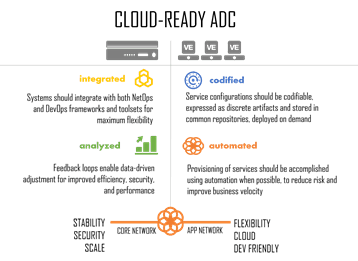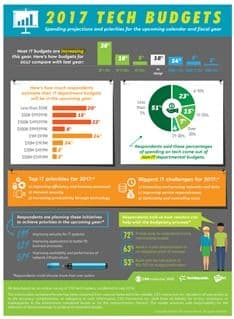
A cloud-ready application delivery controller (ADC) is not your traditional ADC. Available for deployment on custom or COTS hardware, it’s a scalable software-solution supporting both the need for fast, secure, and available delivery and deployment of applications. A cloud-ready ADC enables a modern, two-tiered approach to data center architectures combining traditional stability, security, and scale with modern flexible, cloud, and DevOps-friendly programmatic features.
What’s In It for the Business?
Long before DevOps, or cloud, there was BPM. That’s Business Process Management for those of you who weren’t forced to dive headfirst into its strange, software-driven world by your editors. No, I’m not bitter, but I am scarred, thank you very much. Following closely on the heels of BPM was Business Process Optimization (BPO), but of course that was only after the initial wave of BPM took business by storm and taught it to automate and orchestrate critical business processes as a means to enable agility (rapid changes to processes based on variable business conditions) as well as improve productivity. Optimization came later, but come it did.
Chatter around cloud, DevOps, and increasingly NetOps, as well, focuses more narrowly on the benefits of automation. Namely it promotes the ability to improve time to market, reduce operating costs, and the scale it enables IT organizations to realize in the face of overwhelming application growth. Because agility, you see.
What isn’t as often talked about is that second component, namely productivity. It might seem obvious that automation improves productivity. If automation improves the speed of a task, then naturally an individual leveraging automation can perform many more tasks in a given time period. Because that’s how productivity is measured: tasks per time period completed. Whether that’s hours or days, weeks or months, isn’t the question. It’s a question of volume and whether or not it is increasing as a result of investments made. Investments like that into cloud, or automation, or applications that enable greater speed with which tasks can be completed.
Now, usually when we talk about applications in the context of productivity, people invariably conjure up images of CRM systems or inventory apps that scan RFID tags, or something very business related. We don’t often think about the applications that IT uses to manage, monitor, and deploy the increasingly software-defined services that deliver those applications.
And yet we should. Business success is measured in terms of dollars and growth. And nothing eats into both like burgeoning IT budgets caused by the need for speed and greater frequency of app deployments. Both of which, when turned into nice, neat mathematical equations, look a lot like those used in the business to measure productivity.

Do not dismiss the power of productivity. In a recent Tech Pro Research survey regarding upcoming (2017) budgets, spending and priorities on improving process and productivity consistently ranked in the top three for surveyed respondents. Of the top IT priorities for 2017, the first and third related to improving process and increasing productivity.
That should include improving processes and increasing productivity in IT, as well, as it is increasingly directly responsible for business success. In an application world, delivering the app (ensuring security, speed, and scale) is a critical component, without which applications will fail to realize their full potential.
That means a focus for IT on infrastructure architectures that can enable and promote process efficiently and improvements in productivity of its people, too. Because there are only so many people you can throw at a problem before it begins to hamper both, rather than help. Too many cooks spoil the soup, after all.
IT Productivity and Process Matters
To achieve productivity and optimization of processes in the IT demesne means infrastructure components that are enabled with the right technologies and available in the right environments, all managed with the right systems to ensure a reliable, consistent, and predictable deployment experience. That requires APIs to enable integration with the data center orchestration ecosystem, service templates that enable rapid provisioning and configuration of services using a consistent, standardized baseline, and a centralized command post from which to monitor and manage the distribution of those services across clouds out there, in the public domain, and in here, in the private realm. A Cloud-ready ADC is not just about being ready for deployment in the public cloud, which is an important characteristic, it’s also about being ready for deployment in the private cloud, which is an increasingly important characteristic. And even more than that, it’s about offering opportunity to increase productivity through the economy of scale achieved by automation and orchestration.
But it’s not just about doing it faster and more frequently, it’s also about improving the productivity of those who monitor and manage a growing number of cloud-ready ADCs that support apps in the data center and in the cloud. That means reducing the number of consoles and APIs that must be learned and leveraged. It means offering a better way to license and track usage, one that doesn’t require manual spreadsheets and mastery of the more esoteric aspects of Excel. It means providing a centralized, dev-friendly workflow management platform that enables infrastructure to be treated “as code” by dev and ops without abandoning enterprise requirements for accountability and auditing.
Offloading repeatable manual tasks to automation via scripts and templates has always been an acceptable means of improving productivity and speed within IT. A Cloud-ready ADC recognizes this, and enables IT to mature past simple scripts toward process orchestration and eventually optimization. It embraces cloud in all its forms and enables organizations the freedom to choose the best environment on a per-application basis, without sacrificing services.
A Cloud-ready ADC is a application service platform deployable in the cloud, in the data center, on custom hardware or on COTS. It is programmable and eminently practical as a means to realize the benefits of an “infrastructure as code” approach to app services. It’s supported by tools to manage, monitor, provision, license, and configure across both macro environments (public or private cloud, on-premise or off) and micro environments (production or dev, test or QA).
It’s not a Cloud-ready ADC just because it is ready to deploy in just about any cloud environment. It’s a Cloud-ready ADC because it’s ready to offer the agility, business models, and benefits associated with cloud.
About the Author

Related Blog Posts

Nutanix and F5 expand successful partnership to Kubernetes
Nutanix and F5 have a shared vision of simplifying IT management. The two are joining forces for a Kubernetes service that is backed by F5 NGINX Plus.

AppViewX + F5: Automating and orchestrating app delivery
As an F5 ADSP Select partner, AppViewX works with F5 to deliver a centralized orchestration solution to manage app services across distributed environments.

Build a quantum-safe backbone for AI with F5 and NetApp
By deploying F5 and NetApp solutions, enterprises can meet the demands of AI workloads, while preparing for a quantum future.

F5 ADSP Partner Program streamlines adoption of F5 platform
The new F5 ADSP Partner Program creates a dynamic ecosystem that drives growth and success for our partners and customers.
F5 NGINX Gateway Fabric is a certified solution for Red Hat OpenShift
F5 collaborates with Red Hat to deliver a solution that combines the high-performance app delivery of F5 NGINX with Red Hat OpenShift’s enterprise Kubernetes capabilities.
Phishing Attacks Soar 220% During COVID-19 Peak as Cybercriminal Opportunism Intensifies
David Warburton, author of the F5 Labs 2020 Phishing and Fraud Report, describes how fraudsters are adapting to the pandemic and maps out the trends ahead in this video, with summary comments.
